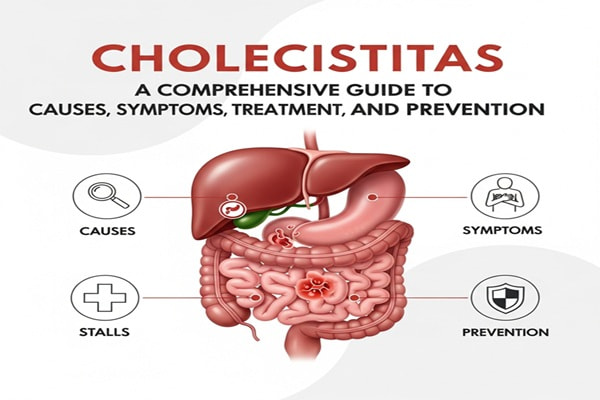
When people hear the term cholecistitas, it often sounds like complicated medical jargon—but it’s something that can affect anyone. This condition, known as gallbladder inflammation, impacts millions every year, and while it might start with mild abdominal pain, it can quickly turn serious if left untreated.
Your gallbladder might be small, but it plays a vital role in your digestive system. Sitting just under your liver, it stores bile—a fluid that helps digest fats. When this organ becomes blocked or inflamed, things can take a painful turn. Cholecistitas usually occurs when gallstones block the bile ducts, causing irritation and swelling. In more severe cases, it can lead to infection, tissue death, or even rupture.
This friendly, easy-to-follow guide breaks down everything you need to know—from what causes cholecistitas and how it’s diagnosed, to effective treatments, prevention strategies, and what recovery looks like.
What Exactly Is Cholecistitas?
Cholecistitas happens when the gallbladder gets inflamed—most often due to a blockage in the cystic duct, the tiny passage that allows bile to flow out. When that flow stops, bile builds up inside the gallbladder, creating pressure and irritation. Over time, bacteria can multiply, turning inflammation into infection.
There are two main forms:
-
Acute cholecistitas, where inflammation comes on suddenly and severely.
-
Chronic cholecistitas, which develops slowly over time from repeated episodes of inflammation.
Since the gallbladder helps digest fats, its inflammation often causes sharp pain in the upper right abdomen, especially after eating heavy or fatty meals. Other symptoms include:
-
Nausea or vomiting
-
Fever or chills
-
Bloating and gas
-
Jaundice (yellowing of the skin or eyes)
Doctors often describe the gallbladder as a “silent organ”—you rarely notice it until it starts screaming in pain.
What Causes Cholecistitas?
Gallstones are the biggest cause, responsible for nearly 9 out of 10 cases. These hard deposits form when bile has too much cholesterol or bilirubin. When a stone gets stuck in the cystic duct, it traps bile inside, and inflammation begins.
But gallstones aren’t the only trigger. Other causes include:
-
Acalculous cholecistitas (no gallstones): Often seen in people who are critically ill, have infections, or have undergone major surgery.
-
Tumors or bile duct blockages from other causes.
-
Severe trauma or prolonged fasting, which can reduce bile flow.
Several risk factors make someone more likely to develop the condition:
-
High-fat diets and obesity
-
Rapid weight loss or crash diets
-
Diabetes and liver disease
-
Pregnancy (due to hormonal changes)
-
Family history of gallstones
-
Being over 40, especially for women
As one gastroenterologist once said, “The gallbladder is a small organ with a loud voice when it’s in trouble.”
How It Feels: Recognizing the Symptoms
The most common sign is sudden pain in the upper right abdomen that can radiate to the shoulder or back. It may come on after eating a large or fatty meal and can last for hours. Some describe it as a sharp, steady ache that feels impossible to ignore.
Other signs include:
-
Fever and chills (indicating infection)
-
Tenderness when pressing the abdomen
-
Loss of appetite or fatigue
-
Digestive discomfort and bloating
In severe cases, complications such as jaundice or infection can develop—warning signs that the inflammation has spread beyond the gallbladder. Chronic cholecistitas may produce milder symptoms, but over time, it can scar and damage the gallbladder wall permanently.
Because these symptoms overlap with other digestive issues like gastritis or ulcers, doctors rely on medical imaging to confirm what’s going on.
How Doctors Diagnose Cholecistitas
Diagnosis starts with your story—where it hurts, when it hurts, and what makes it worse. From there, a doctor may gently press on your abdomen to check for Murphy’s sign—a sharp pain response that helps pinpoint gallbladder inflammation.
Next come tests, such as:
-
Blood tests to check for signs of infection or liver involvement.
-
Ultrasound, the go-to test for spotting gallstones and swelling.
-
CT or MRI scans, used for complicated or uncertain cases.
-
HIDA scan, which tracks bile movement to confirm blockages.
Early diagnosis is critical. As many gastroenterologists note, catching cholecistitas early can mean the difference between a simple outpatient treatment and a hospital emergency.
The Different Types of Cholecistitas
Cholecistitas doesn’t always look the same in every patient. Understanding the type helps guide the right treatment:
| Type | Cause | Key Features | Common Risk Group |
|---|---|---|---|
| Acute Calculous | Gallstones | Severe pain, fever, inflammation | Most common type |
| Acalculous | Infection, trauma, critical illness | No stones, high mortality | ICU or post-surgical patients |
| Chronic | Repeated inflammation | Scarring, digestive discomfort | Long-term gallstone sufferers |
| Gangrenous | Poor blood flow | Tissue death, risk of sepsis | Elderly, diabetics |
| Emphysematous | Gas-forming bacteria | Air in gallbladder wall | Older diabetic men |
Each type has different severity levels, but all require timely attention. Left untreated, acute inflammation can spiral into gangrene or rupture—both life-threatening emergencies.
Treatment Options: From Medicine to Surgery
Treatment depends on how severe the inflammation is and what caused it. For mild or early-stage cholecistitas, doctors typically start with:
-
Antibiotics to control infection
-
Pain relievers and IV fluids to manage symptoms and prevent dehydration
-
Fasting temporarily to rest the gallbladder
However, when gallstones are to blame, surgery is usually the best long-term solution.
1. Laparoscopic Cholecystectomy
The most common and least invasive procedure, where small incisions allow surgeons to remove the gallbladder using a camera-guided tool. Recovery is usually quick—most people are home within a day or two.
2. Open Cholecystectomy
Used in severe or complicated cases, such as infection or large stones. It involves a larger incision and a longer recovery period but remains a reliable option for complex cases.
3. Cholecystostomy
For patients who aren’t stable enough for surgery, a tube can be inserted through the skin to drain bile temporarily. This helps relieve pressure until surgery becomes safe.
| Treatment | When Used | Goal | Outcome |
|---|---|---|---|
| Antibiotics & IV Fluids | Mild or early cases | Control infection | Stabilizes condition |
| Laparoscopic Surgery | Standard cases | Remove gallbladder | Quick recovery |
| Open Surgery | Severe complications | Full removal | Longer recovery |
| Cholecystostomy | High-risk patients | Drain bile | Temporary relief |
What Happens If It’s Ignored?
Ignoring cholecistitas can lead to severe, sometimes fatal complications.
Here’s what can happen:
-
Perforation (rupture) of the gallbladder, causing infection to spread inside the abdomen.
-
Gangrene, where tissue dies from lack of blood flow.
-
Abscesses or pus pockets forming around the gallbladder.
-
Bile duct infections or sepsis, both potentially life-threatening.
-
Gallbladder cancer (rare but possible after long-term inflammation).
Early diagnosis and prompt treatment can prevent these outcomes entirely.
Also Read : Kirby Dedo: Origins, Symbolism, and Modern Relevance – A Complete Informational Guide
Preventing Cholecistitas: Small Changes, Big Impact
The best prevention strategy is keeping gallstones from forming in the first place. Here’s how:
Maintain a healthy weight: Obesity and rapid weight loss both increase risk.
Eat a balanced diet: Focus on fiber-rich fruits, vegetables, and lean proteins while reducing fried and fatty foods.
Stay active: Exercise helps maintain healthy cholesterol and bile flow.
Hydrate well: Proper hydration supports digestion and bile balance.
Eat regular meals: Skipping meals or fasting for long periods slows bile movement, increasing the chance of stone formation.
As one gastroenterologist puts it, “A healthy gallbladder thrives on balance—not extremes.”
Looking Ahead: Future Treatments on the Horizon
Medical innovation is opening new doors for managing gallbladder disease. Researchers are exploring:
-
Artificial intelligence to help interpret ultrasound scans faster and more accurately.
-
Less invasive surgical tools to shorten recovery times for high-risk patients.
-
Medications that dissolve gallstones, which could eventually reduce the need for surgery.
-
Genetic testing to identify individuals predisposed to gallstone formation early in life.
These advances promise safer, quicker, and more personalized care for future patients.
Final Thoughts
Cholecistitas reminds us how vital even the smallest organs can be. It starts quietly but can become life-threatening without timely care. The good news? With the right lifestyle choices and medical attention, most people recover fully and live perfectly healthy lives—sometimes even better than before.
If you ever feel sharp pain under your ribs, especially after eating fatty food, don’t brush it off. Get checked, stay informed, and act early. When it comes to gallbladder health, quick action can truly save lives.
FAQs
1. What’s the most common cause of cholecistitas?
Gallstones blocking the cystic duct cause about 90% of cases.
2. Can it go away without surgery?
Sometimes mild inflammation improves with antibiotics, but most patients need surgery to prevent recurrence.
3. Who’s most at risk?
Women over 40, people with obesity, diabetics, and those with a family history of gallstones.
4. What foods should be avoided?
Fried, fatty, and processed foods should be minimized to prevent flare-ups.
5. Can you live normally after gallbladder removal?
Yes! Most people live comfortably post-surgery. You may just need to adjust your diet slightly for better digestion.


